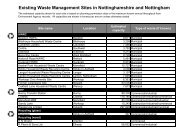Flooding: Drainage & Watercourses - Nottinghamshire County Council
Flooding: Drainage & Watercourses - Nottinghamshire County Council
Flooding: Drainage & Watercourses - Nottinghamshire County Council
You also want an ePaper? Increase the reach of your titles
YUMPU automatically turns print PDFs into web optimized ePapers that Google loves.
Leicestershire and Lincolnshire across eight districts and covering 555<br />
square kilometres. IDBs cover contour based areas defined as eight feet<br />
above highest known flood levels. Their function is to maintain natural open<br />
watercourses – NAIDB maintains 600 kilometres of watercourses. It is<br />
managed by a board of elected members (and local councillors) and meets<br />
four times a year.<br />
50. Funding of the board is through a drainage rate on agricultural land.<br />
£500,000 is also contributed by Newark and Sherwood District <strong>Council</strong>.<br />
Newark and Sherwood were badly affected by the summer floods –<br />
especially west of the Trent (e.g. Southwell & Lowdham). NAIDB employees<br />
assisted where they could but were not in a position to supply sandbags.<br />
The Board had recently completed 6-9 months weed cutting on watercourses<br />
associated with flooding.<br />
51. Mr Broadhead stated that under the Land <strong>Drainage</strong> Act, farmers and other<br />
landowners could be compelled to clear watercourses. However, NAIDB has<br />
never taken legal action against anyone for failure to maintain a<br />
watercourse; matters have been resolved by agreement. In the 1970’s<br />
grants were paid by the Ministry of Agriculture Fisheries and Food to assist<br />
in the clearance of watercourses.<br />
Representation from Parish <strong>Council</strong>s<br />
52. The Select Committee wrote to Parish <strong>Council</strong>s in Bassetlaw, Gedling and<br />
Newark and Sherwood inviting submission of information on the response to<br />
the summer floods (e.g. what went well, where improvements could be<br />
made, and whether or not there was effective partnership working). These<br />
responses are summarised in Appendix A. In addition, a number of Parish<br />
<strong>Council</strong>s affected by the summer floods made representation to the Select<br />
Committee on 28 April. The following points were raised:<br />
53. Balderton Parish <strong>Council</strong> (<strong>Council</strong>lor Angela Jarvis and Mr Bernard Gascoine)<br />
• The backwash of sewage experienced at Staple Lane<br />
• Blockage of a watercourse with a fencepost<br />
• The small size of drains – only nine inches in diameter<br />
• Complex and long-standing issues around the culvert under Warwick<br />
Road<br />
54. North Leverton with Habblesthorpe (Mr Colin Walker) – a quarter of North<br />
Leverton was flooded – the residents are grateful for the reinstatement of<br />
roads and the swift response of John McGuigan from the Emergency<br />
Planning Department. The level of consultation from <strong>Nottinghamshire</strong><br />
<strong>County</strong> <strong>Council</strong> was good but concerns remained about the length of time<br />
taken to re-open the local primary school that was closed by the flooding<br />
(not due to re-open until December 2008).<br />
55. Mr Walker explained that North Leverton came under Laneham Internal<br />
<strong>Drainage</strong> Board – which is operated independently by consultants based in<br />
Doncaster - and had suffered worsened flooding as a result of the inundation<br />
of a pump located at the West Burton Power Station. On a point of<br />
clarification, Mr Broadhead of Newark Area Internal <strong>Drainage</strong> Board (NAIDB)<br />
added that since pumps could be subject to failure and power loss some<br />
12




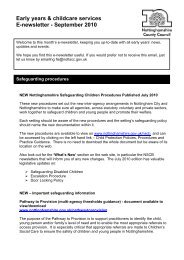


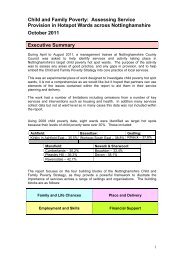

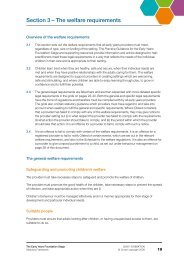
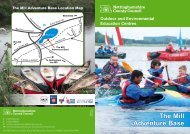


![Every Parent Matters [PDF 463KB] - Nottinghamshire County Council](https://img.yumpu.com/47250686/1/184x260/every-parent-matters-pdf-463kb-nottinghamshire-county-council.jpg?quality=85)
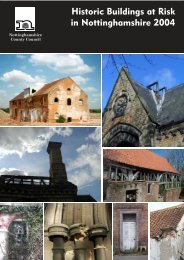

![School Employee Domestic Violence and Abuse Policy [PDF 228KB]](https://img.yumpu.com/46294446/1/184x260/school-employee-domestic-violence-and-abuse-policy-pdf-228kb.jpg?quality=85)
